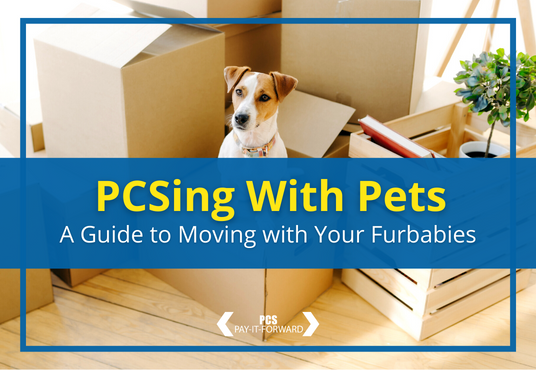PCSing isn’t a fun task to begin with, but when you add kids, pets, or both to the mix, things can get even more complicated. But good luck with your human children, because today we’re going to focus on our furry friends and making the transition from old place to new as safe and smooth for them, and you, as (humanly) possible!
Before Your Move: The Truth About Cats & Dogs
Let’s be honest, dogs travel much more easily than cats, that’s just a fact. But if you have a squeamish dog or laid-back kitty, that’s great to know ahead of time because the best thing you can possibly do when you get your orders is begin preparing your animals for the big move. Start by getting your pets accustomed to being in a carrier if they aren’t already. Introduce them into the space by putting an article of your clothing and their favorite toys inside, then by giving them treats while they’re in there and doing it all in the comfort of the home they already know and love.
Packing Day: Should They Stay or Should They Go Now?
Strangers in and out of the house, boxes being packed with that loud awful tape noise, doors left open without the consideration of a fleeing freaked-out pet. You need to have a plan for your pets on this hectic day that will keep them safe and calm. Perhaps you should leave them with a friend or think about boarding them for a day or two. But either way, they should not be left in the thick of things. Even if you simply leave them in a back room where it’s quiet, your pets should always be kept in a secure and tranquil location when it’s time for the action to start.
On the Road Again
Don’t forget to pack for your pet for your time on the road. Make sure you have their leash, food and water dish, bottled water, pet first aid kit, disposable litterbox (for a cat), and throw in some blankets and toys for their comfort and entertainment as well. If crossing state lines, make sure you get a health certificate from your vet in the chance that you’re pulled over and asked to provide one. Be sure you have all identification tags with correct contact information and that any microchip records are up to date.
Always make sure your pets are secured and safe while driving. Loose pets are not only vulnerable in accidents, but they can also provoke distracted driving that causes one. Dogs should be in crates or restrained with a safety harness. Cats should be in a carrier, preferably one with a cover to keep them calm when the trip begins. And don’t forget to take your dogs out at every pit stop!
Over Night Stays
If you’ll be making an overnight stop, remember to book a pet friendly location. Be sure to call the specific location and confirm the pet policy and any additional fees as even corporate or chain hotels can vary in their protocols. Some hotels limit access to dogs over 30 lbs, and don’t allow birds, exotic pets or even cats.
Alternate Transportation: Turn to the Professionals
If you have TDY enroute orders or have more exotic pets like birds, horses or even very large dogs, it might be a better idea to find a professional carrier who can handle the details of getting your pet from one place to another. If you do have young children or will be stuck in a hotel for a longer amount of time, this is definitely something worth considering. Remember to begin looking for a reputable company at least 30 days in advance to give you ample time to find the best fit.
Join your local PCS Pay-it-Forward Base support group for more support from local military families who are ready to help!
Happy PCSing!




